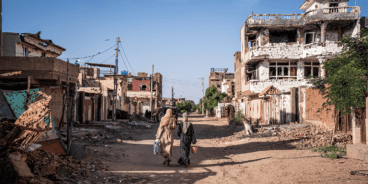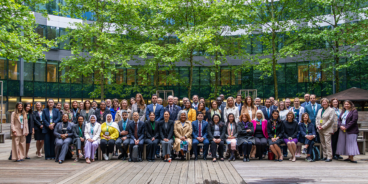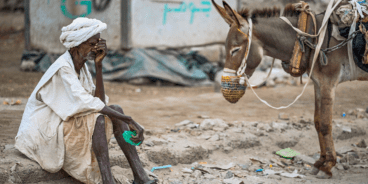
Uniting to Support the Responsibility to Protect: Preserving the Spirit of the 2005 Agreement
Thursday, 25 September 200| 9:00-11:00 AM | Millennium UN Plaza Hotel One United Nations Plaza, 44th Street
The forthcoming report of the UN Secretary-General, and a debate in the General Assembly – particularly sought by skeptics of the R2P doctrine – present a series of pivotal moments for the doctrine in the coming months. To date, skeptics have proved more organized than supporters of R2P. This event brought together some of the strongest supporters of R2P to discuss how work together more effectively to defend and promote the norm and to ensure that any General Assembly debate does not result in a watering down of the historic 2005 consensus.
The vigorous discussion focused on the core principles of R2P, their application to current situations, and on the need for coordinated action to preserve and advance them. The discussion took stock of how the principle has been used, touched on concerns regarding its implementation, made recommendations for its advancement and issued warnings about the ways it is being frustrated. The following themes emerged.
Vision
R2P is founded on a simple commitment: “Rwanda Never Again.” This commitment resonates with global publics, as it does with policy elites. In defending the doctrine against critics, and in explaining it to citizens, we must not lose sight of this fundamental moral principle at the heart of the R2P doctrine.
Scope
R2P only applies to genocide, ethnic cleansing, war crimes and crimes against humanity, as set forth in paragraphs 138 and 139 of the World Summit Outcome Document.
Participants warned against the expansion of its application beyond these mass atrocity crimes. In this context, participants discussed the invocation of R2P to apply to the victims of Cyclone Nargis. While some believed that applying R2P to this situation was an expansion of the concept, others felt it was appropriate to question whether the Burmese regime, by its gross failure to respond to its citizens’ needs in the wake of Cyclone Nargis, had committed a crime against humanity. In situations such as this, several participants argued that R2P supporters must arrive at a common understanding about when and how they invoke the R2P norm to avoid damaging dissent.
Tactics
There was much emphasis on the importance of prevention and early action. One minister advised that it is important to emphasize prevention, not intervention. Another commented that effective peace-building in settings where R2P crimes have occurred is a crucial aspect of prevention. Yet participants were united that supporters should stand by the full aspect of the norm and not allow governments or the UN Security Council to evade its responsibilities stipulated by the 2005 agreement. Supporters were urged to engage in outreach to promote this understanding of the norm and ensure its effective practice.
Application
R2P must be applied to real life situations. Participants raised the examples of Burma, Darfur and Zimbabwe. There was agreement, moreover, that the world should not wait until actual atrocities have occurred to invoke the R2P norm. R2P poses a challenge to governments and the wider international community to prevent mass atrocity crimes.
Friends of R2P should seek to coordinate their decision-making and diplomacy in this regard. It will also be important for governments to learn from each experience to ‘develop a better feel’ for how best to ensure that applying the doctrine galvanizes action to save lives rather than simply stirs up controversy that impedes effective response.
Tools/Measures
The range of measures to implement R2P was also addressed. One participant described the tool box to implement R2P as ‘well filled’ across the spectrum of responses, though another demurred, arguing that the international community has not sufficiently well developed tools or consensus on how to use them to fulfill the responsibility to protect. Here, a distinction was made between R2P and humanitarian intervention. R2P, even though it applies to a narrow set of crimes, demands the appropriate application of a broad range of measures – diplomatic, political, judicial and military. All of these must be explored. It is necessary to invest in assistance to states and regional institutions to build capacity and strengthen all the tools in the tool box essential to prevent and halt mass atrocities.
On the use of force
There was agreement that at times prevention will not succeed and enforcement measures will be needed. Criteria to guide the use of force were raised as important to reassure skeptics about the potential misuse of force under R2P. Supporters were called upon to decide on a strategy regarding such criteria – whether to push for a resolution in the General Assembly or Security Council, in due course, or to argue for their application and adoption in practice.
Judicial measures to fulfill R2P
Participants also viewed ending the impunity of those who commit mass atrocities as another vital part of the R2P ‘tool box,’ albeit one that is proving controversial, as evident in the current international debate about the indictment issued by the Prosecutor of the International Criminal Court against President Bashir of Sudan. There was concern from some that the movement to postpone prosecution would damage the R2P norm. Participants also presented the divided views regarding the arrest and trial of Rwandan genocidaires outside Rwanda; one participant argued that this was necessary to uphold R2P commitments while another noted that this was seen by some as unwarranted intervention.
Participants were urged to come to common agreement on how to use the judicial aspects of the R2P tool box to uphold and advance the norm in practice.
Among other words of warning raised by participants:
Avoid double standards
Supporters have to practice what they preach, and beware of double standards when seeking to uphold the commitments to R2P. This requires action from R2P supporters on a range of issues – from implementing commitments to the Millennium Development Goals to making progress in multilateral trade talks.
Speak out against misuse
States should be reassured that R2P will not be used as cover for national interests and that friends of the concept will work to prevent it from being used as a pretext for unilateral action or unwarranted intervention in domestic affairs of sovereign states. The 2003 invasion of Iraq and Russia’s inappropriate invocation of R2P to explain its recent military intervention in Georgia are two cases in point. R2P must not come to be seen as a weapon to be wielded by a handful of countries.
Shared strategy and coordination
The conversation also highlighted a number of tasks for outreach and diplomacy in order to promote understanding and to consolidate support for the 2005 agreement. One of the resounding points of consensus is that the ‘friends’ of R2P need to engage in a more concentrated and coordinated effort to defend and promote the norm. This includes deciding on a strategy of advancing R2P within regional organizations in all regions of the world, recognizing that such efforts will be more fruitful in some regional organizations than others.
Challenges at the UN
The current climate at the UN is difficult for issues relating to R2P. This includes two double vetoes in the Security Council, challenges with the new Human Rights Council, and increasing difficulty of passing country resolutions in the General Assembly. This political climate makes it easier for those who want to escape scrutiny.
The Human Rights Council has the potential to play a role to prevent mass atrocities, both to address specific situations and to build confidence that all member states share obligations to uphold human rights and international humanitarian law. The Universal Periodic Review Mechanism can contribute in this regard. Ministers expressed concern about the effectiveness of the Council, however, and one possible step forward is to press the new US administration to become a member of the Human Rights Council.
Speakers
-
-
- Maxime Verhagen, Minister of Foreign Affairs of the Kingdom of the Netherlands
- Bruno Stagno Ugarte, Minister of Foreign Affairs of Costa Rica
- Dr. Iftekhar Ahmed Chowdhury, Minister of Foreign Affairs, Government of the People’s Republic of Bangladesh
-
Participants
-
-
- Mark Malloch Brown, Minister for Africa, Asia and UN, United Kingdom
- Karel De Gucht, Minister of Foreign Affairs, Belgium
- Gareth Evans, President, International Crisis Group, Co-Chair of the International Advisory Board of the Global Centre for the Responsibility to Protect
- Ulrik Federspiel, Permanent Secretary of State for Foreign Affairs, Denmark
- Juan Manuel Gomez-Robledo, Vice-Minister for Multilateral Affairs and Human Rights, Mexico
- Oh Joon, Deputy Minister of Multilateral, Global and Legal Affairs, Republic of Korea
- Stephen Smith, Minster of Foreign Affairs, Australia
-
Moderator
-
-
- James Traub, Director of Policy, Global Centre for the Responsibility to Protect
-
Related Content


11th Meeting of the Global Network of R2P Focal Points Outcome Document
